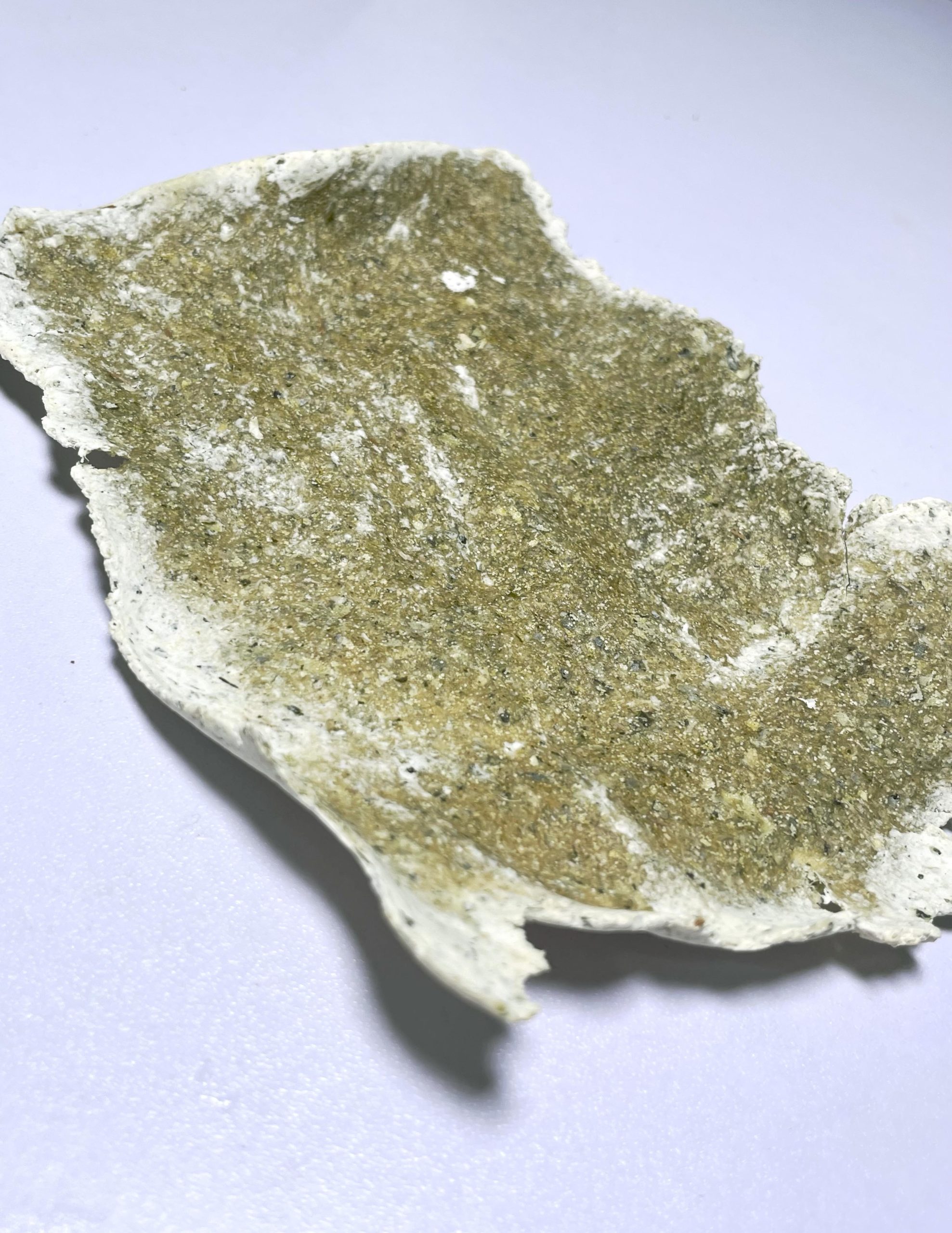I. Material Materials Amounts SCOBY 1 piece, 8-10 cm diameter Red Cabbage Dye: Purple Color 250 mL Red Cabbage Dye: Blue Color 250 mL Tools: Plate, Glass Jars II. Procedure 1. Dry SCOBY on a plate for 7-10 days until completely dry. 2. Dip one side of dried SCOBY into purple-colored dye. Hold for approximately […]
I. Material Ingredient Amount Wheat (barley) seeds 75g Water Unlimited Notes: The ingredients mentioned above are used for covering a 10cm*20cm space. The ingredients increase proportionally according to the required dimension. Tools: Flat container, grid plate, thin cloth/thin paper, water spray bottle, 3D printed pattern (optional) II. Procedure 1. Wash and soak the seeds in […]
I. Material Ingredient Amount Carrageenan 7.5g Dragonfruit pigment + water 225ml Glycerin 2ml Vinegar 20ml II. Procedure 1. Cut carrageenan into four to five pieces and add them into water with dragonfruit pigment gradually. Stir the solution until carrageenan is almost dissolved. 2. Add glycerin and vinegar and stir. 3. Pour the solution onto the […]
I. Material Ingredient Amount Watermelon peel Moderate Vinegar 25mL Potato starch 50g Tools: blender, gauze, pot, oven, rod, and baking sheet. II. Procedure 1. Slice the watermelon peels into small pieces. 2. Pour the pieces into a blender to crush. 3. Pour the pulp onto the gauze and squeeze out the liquid. 4. Mix and […]
I. Material Ingredient Amount(spoons) Potato starch 2 Water + Orange peel pigment 4 Glecyrin 2 Vinegar 2 Water + Blueberry pigment 4 Notes: The pigments can be saved for later uses by storing in the fridge. II. Procedure 1. Mix water and orange peel pigment with potato starch well at around 130 degree and stir […]
I. Material Ingredient Amount Glycerin 2.7g Water 400mL Carrageenan 18g Gauze 1 piece Blue Butterfly Pea Moderate Note: Add the blue butterfly pea little by little until the solution reaches the expected color. Tools: Spoon, spatula, pot, heat plate, beaker, scale, an 18cm * 20cm mode. II. Procedure 1. Cut carrageenan into four to five […]
I. Ingredients Ingredient Material(teaspoon) Glycerin 2 Potato Starch 2 Water(/Pigment Solution) 8 Vinegar 2 Notes: Do with the same amount twice, but substituting water with pigment solution in the second time. Alter the pigment concentration by the color density you want. Tools: Spoon, spatula, pot, heat plate, water-proof cloth, and a cylinder. II. Procedure 1. […]
I. Material Ingredient Amount Milk Moderate vinegar about 2/3 of the amount of milk Tools: kitchen paper, pot and mold. II. Procedure1. Warm the milk a bit. 2. Pour the vinegar into it. 3. Mix and wait for several minutes. 4. Pour the liquid onto sheets of kitchen paper and squeeze out extra liquid. 5. […]
I. Material Ingredient: watermelon peels, water, vinegar, glycerin, and potato starch. Tools: blender, bowl, gauze, pot, and mold. II. Procedure 1. Slice the watermelon peels into small pieces. 2. Pour the pieces into a blender to crush. 3. Pour the pulp onto the gauze and squeeze out the liquid. 4. Mix and warm up water […]
I. Material Ingredient: Ingredient Amount Warm water 62.5mL Alginate 3.75g Corn starch 3.75g Glycerin 1.25g Peanut shell 30-40g Tools: Electronic scale, 300mL beaker, 5mL pipette, pot, heat plate, and stirring rod. II. PROCEDURE 1. Mix water with corn starch. 2. Pour alginate into the solution and mix. 3. Add glycerin into the solution and heat […]

I. Material
| Materials | Amounts | |
| SCOBY | 1 piece, 8-10 cm diameter | |
| Red Cabbage Dye: Purple Color | 250 mL | |
| Red Cabbage Dye: Blue Color | 250 mL |
II. Procedure
1. Dry SCOBY on a plate for 7-10 days until completely dry.
2. Dip one side of dried SCOBY into purple-colored dye. Hold for approximately 25 seconds inside the dye to maximize absorption without letting it become too rehydrated.
3. Repeat on the other side of the SCOBY with the blue-colored dye.
4. Lay SCOBY back on plate for 48 hours, or until dry again.
5. Pour red cabbage dyes into separate glass jars and place in the fridge until next use.
III. Results
The purple cabbage dye has a vibrant pink pigmentation on the SCOBY, however the blue dye does not dry blue, and actually turns a light brown. There are also white spots that the blue dye formed on the SCOBY. These issues are potentially due to the fact that the blue cabbage dye is made with baking soda, and the SCOBY does not react well with that. In the spots where the blue dye did seem to take, it turned green which is likely because of the yellow tint of the SCOBY mixing with the blue pigment. It is unknown why some spots kept color while the rest faded to brown.
Other Observations: Dip dying in red cabbage dye does not make the SCOBY mold.
Disclaimer: Drying times may vary depending on the level of humidity in the air.









